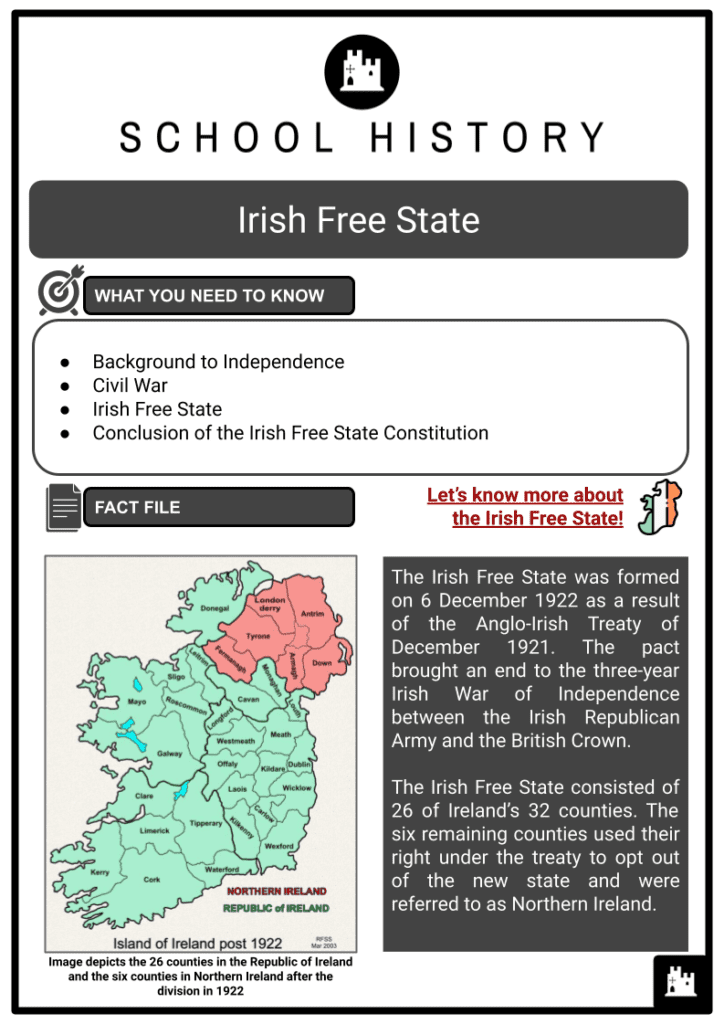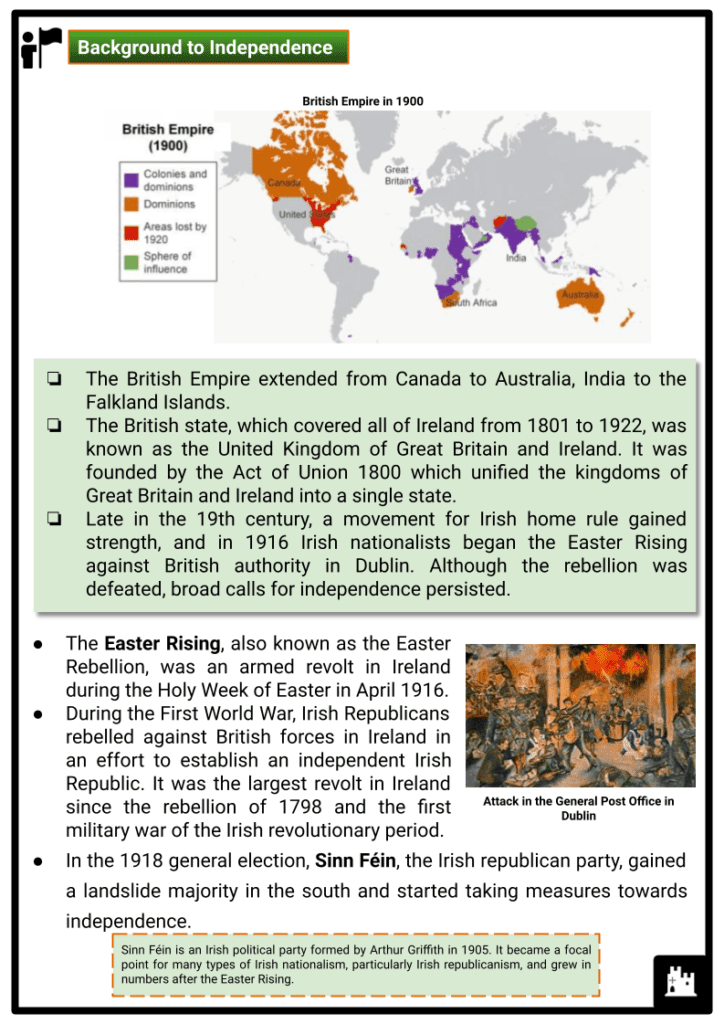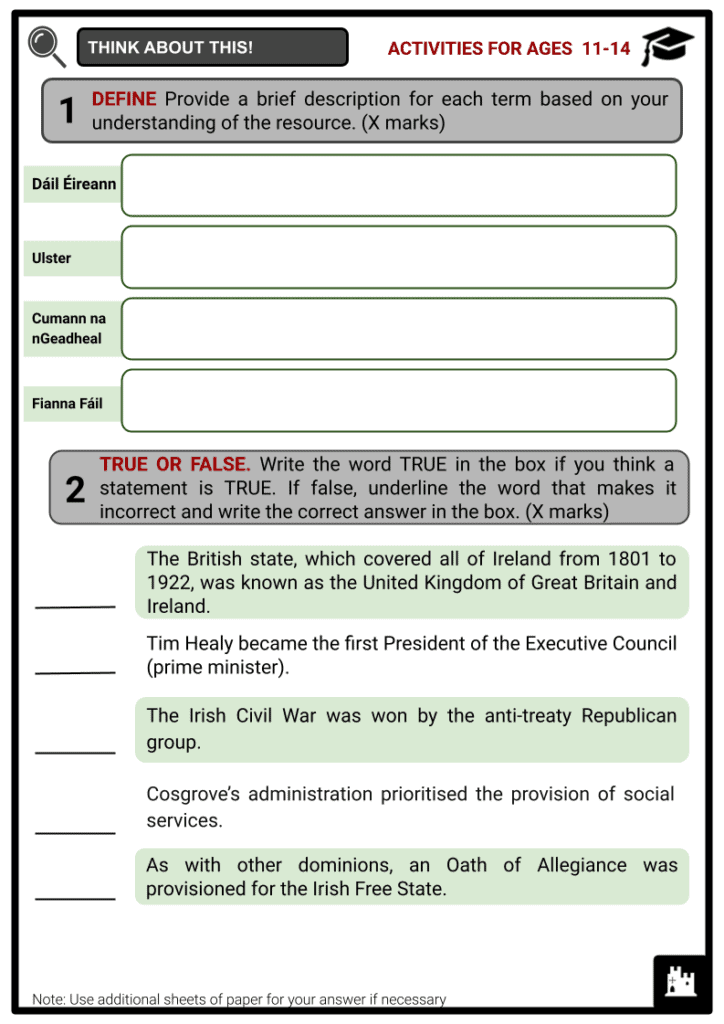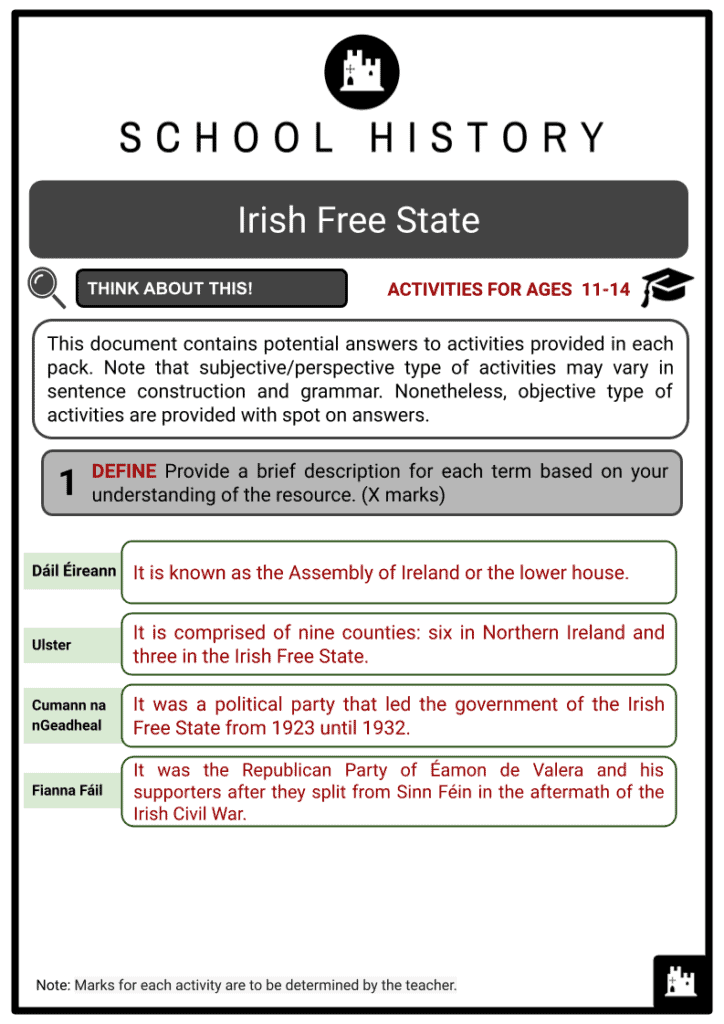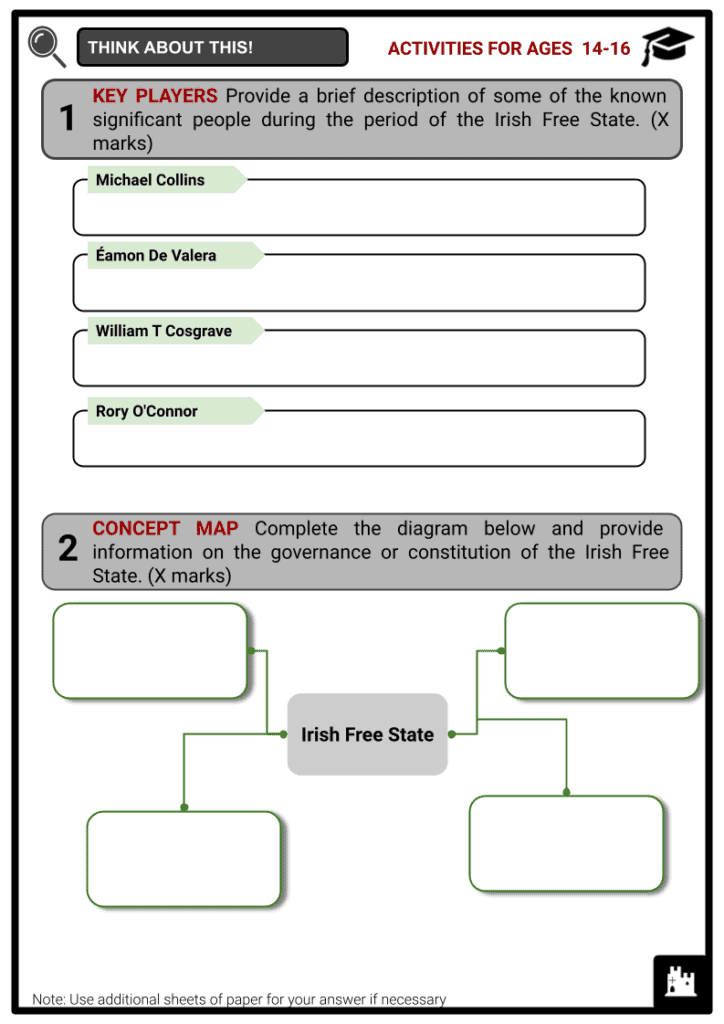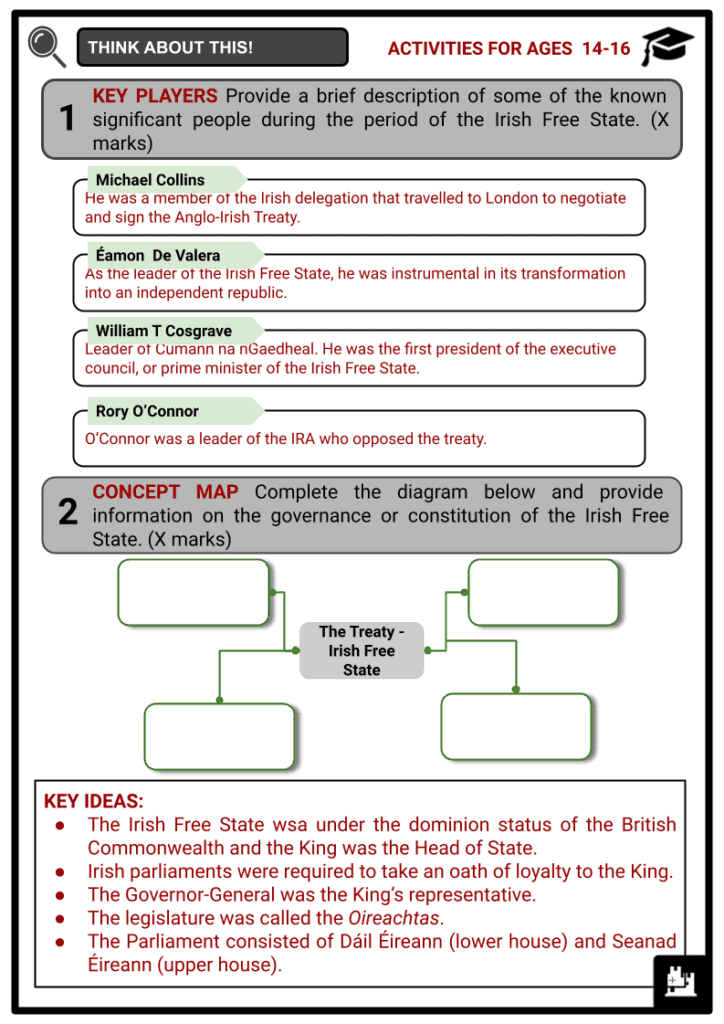Irish Free State Worksheets
Do you want to save dozens of hours in time? Get your evenings and weekends back? Be able to teach about the Irish Free State to your students?
Our worksheet bundle includes a fact file and printable worksheets and student activities. Perfect for both the classroom and homeschooling!
Summary
- Background to Independence
- Civil War
- Irish Free State
- Conclusion of the Irish Free State Constitution
Key Facts And Information
Let’s find out more about the Irish Free State!
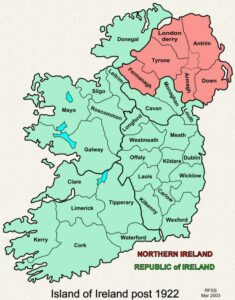
The Irish Free State was formed on 6 December 1922 as a result of the Anglo-Irish Treaty of December 1921. The pact brought an end to the three-year Irish War of Independence between the Irish Republican Army and the British Crown. The Irish Free State consisted of 26 of Ireland’s 32 counties. The six remaining counties used their right under the treaty to opt out of the new state and were referred to as Northern Ireland.
Background to Independence
- The British Empire extended from Canada to Australia, India to the Falkland Islands.
- The British state, which covered all of Ireland from 1801 to 1922, was known as the United Kingdom of Great Britain and Ireland. It was founded by the Act of Union 1800 which unified the kingdoms of Great Britain and Ireland into a single state.
- Late in the 19th century, a movement for Irish home rule gained strength, and in 1916 Irish nationalists began the Easter Rising against British authority in Dublin. Although the rebellion was defeated, broad calls for independence persisted.
- The Easter Rising, also known as the Easter Rebellion, was an armed revolt in Ireland during the Holy Week of Easter in April 1916.
- During the First World War, Irish Republicans rebelled against British forces in Ireland in an effort to establish an independent Irish Republic. It was the largest revolt in Ireland since the rebellion of 1798 and the first military war of the Irish revolutionary period.
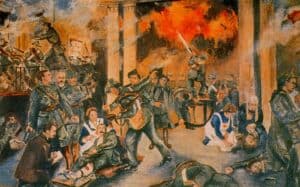
Attack in the General Post Office in Dublin - In the 1918 general election, Sinn Féin, the Irish republican party, gained a landslide majority in the south and started taking measures towards independence. Sinn Féin is an Irish political party formed by Arthur Griffith in 1905. It became a focal point for many types of Irish nationalism, particularly Irish republicanism, and grew in numbers after the Easter Rising.
- The 69 Sinn Féin Members of Parliament established their own legislature, which came to be known as Dáil Éireann (Assembly of Ireland).
- The Dáil was founded in Dublin on 21 January 1919 and approved the Declaration of Independence. Their platform refused to recognise Westminster as the British parliament.
- The First Dáil’s assembly coincided with the start of the Irish War of Independence when two members of the Royal Irish Constabulary, backed by the British government, were attacked and killed by an armed nationalist group, which sparked the war.
- The following War of Independence was waged between the Irish Republican Army (IRA) and British security forces until July 1921, when a truce was declared.
- In October, officials of the British government and the Dáil began discussions in London, which ultimately resulted in the signing of the Anglo-Irish Treaty on 6 December 1921.
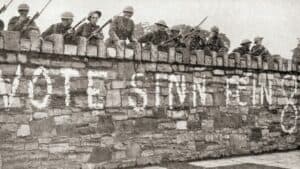
British soldiers defending a wall during the Irish War of Independence
Anglo-Irish Treaty
- The 1921 Anglo-Irish Treaty, also known as The Treaty, ceased the Irish War of Independence.
- The agreement was signed on 6 December 1921, in London, by officials of the British government, conducted by Prime Minister David Lloyd George and leaders of the Irish Republic, notably Michael Collins and Arthur Griffith.
- It allowed the Irish Free State to become self-governing within a year, which was referred to as ‘dominion status’. The treaty ultimately granted the Irish Free State political independence. However, it was still a part of the British Commonwealth, a status that is similar to Canada.
- It momentarily gave Ulster, the nine most northerly counties in Ireland, the right to opt out of a unified Ireland and remain part of the United Kingdom.
Civil War
- On 6 December 1922, precisely one year after the treaty was signed, the government of the Irish Free State assumed political authority. An Oath of Allegiance was established. The next day, Northern Ireland made the decision to stay independent from the Irish Free State.
- As a newly independent nation, the early months and years of the Irish Free State faced numerous internal problems.
- Parliamentarians took the Irish Oath of Allegiance personally to the monarch. It was criticised by Republicans and nationalists for mentioning the Crown on the grounds that it constituted a direct pledge to the Crown. As a dominion, the King (and, by extension, the British) remained Head of State, and this practical reality impacted public discourse on the subject.
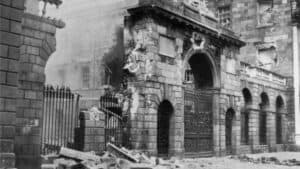
During the Irish civil war of 1923, the Four Courts, Ireland's Supreme Court, was brutally bombarded - Opposition to this was based on the fact that it was not thoroughly discussed and explained before the signing in December 1921 of the Anglo-Irish Treaty and on the fact that many members of the second Dáil Éireann, elected without opposition in May 1921, had already sworn to uphold the Irish Republic.
- The Irish Civil War erupted in June 1922 – April 1923, when those who accepted the Anglo-Irish Treaty clashed with others who did not recognise the state as a free state.
- The debate surrounding the oath was one of the primary causes of the Irish Civil War between the treaty’s supporters and opponents.
- Those who supported the treaty said that it was a step towards greater independence, which would be attained via more peaceful ways.
- The pro-treaty group, led by Michael Collins and Arthur Griffith, organised in a Provisional Government, began the process of establishing the Irish Free State founded by the treaty.
- The anti-treaty Republican forces were led by Éamon de Valera, who had resigned as President of the Republic upon the treaty’s ratification.
- The majority of the IRA, led by Rory O’Connor, rejected the treaty on the grounds that it disestablished the Irish Republic, which they had pledged to preserve, and that it required Irish MPs to swear allegiance to the British monarchy.
- Éamon de Valera led political opposition to the treaty in a new party named Cumann na Poblachta (‘Family/Children of the Republic’).
- The civil war cost almost 1,000 lives, including some of the major players in the Irish independence movement, such as Michael Collins, who was assassinated in Cork on 22 August 1922.
- Ultimately, the civil war was won by the Free State forces led by Cumann na nGeadheal (‘Society of the Gaels’ political party).
- William T Cosgrave, a more conventional figure, replaced Collins as the first head of government (‘president of the Executive Council’) of the Irish Free State.
Irish Free State
- The Irish Free State (Saorstát Éireann) comprised 26 counties, which is four-fifths of Ireland, with Dublin as its capital.
Religion and Flag
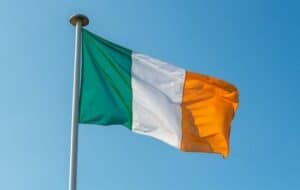
- The government declared religious freedom for all citizens and a new flag was established to represent this. The three coloured vertical bars were orange (Protestants), green (Catholics) and white (peace between them).
Currency
- The government of the Irish Free State approved the Coinage Act, which authorised the Minister of Finance to mint silver, nickel and bronze coins. The currency was originally known as the Saorstát (Free State) pound. Their value remained pegged to British sterling. British money remained equally accepted in the Free State.
- In 1937, when Ireland (Éire) replaced the Free State, the pound became known as the ‘Irish pound’, and its coins were stamped with ‘Éire’.
Government
- The majority of the independence’s symbols and powers were granted by the treaty. These featured a parliamentary democracy with its own government, courts, and a written constitution that could be modified by the Oireachtas (legislature).
- The Constitution of 1923 set up a parliamentary system of government under a form of constitutional monarchy that was very similar to the Constitution of 1930. The administration of the Free State was composed of the Governor-General, head of state who represented the king, and the Executive Council (cabinet).
- WT Cosgrave became the first President of the Executive Council (prime minister).
Governors-General of the Irish Free State (1922–1936)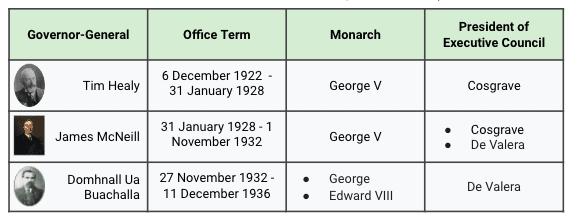
Legislature
- The Parliament consisted of Dáil Éireann (the lower house, also known as the Dáil) with 153 seats and Seanad Éireann (the upper house, also known as the Seanad) with 60 seats.
- The principal political parties were Cumann na nGaedheal under W T Cosgrave from 1922–1932 (pro-Dominion and pro-Commonwealth and centre-right nationalism); and Fianna Fáil under Éamon de Valera from 1932–1937 (Christian democracy and centre-right).
Cumann na nGaedheal Party (1922–1932)
- Large portions of the Irish Free State’s infrastructure were in bad state after the civil war. The Cumann na nGaedheal administrations, led by WT Cosgrave, were more concerned with establishing the state’s essential institutions than with social or political change.
- One of the initial responsibilities of the new prime minister, WT Cosgrave, was to rebuild bridges and railroads that had been damaged or destroyed during the conflict.
- The Garda Sochána was founded as an unarmed and politically neutral force by the Cumann na nGaedheal administrations, making it comparatively unpolluted by the ferocity of the civil war.
- The Cosgrave administration viewed its duty on the economic front as aiding the Irish agricultural export industry by consolidating farms and enhancing the quality of their products. In an effort to minimise the public debt, the first Minister of Finance, Ernest Blythe, reduced governmental expenditure from £42 million in 1923 to £27 million in 1926.
- Instead of prioritising the provision of social services, the Cumann na nGeadhael administration reduced income tax from 5 to 3 shillings. The Shannon hydroelectric system was an exception to the typically low level of public investment, as it was Ireland’s first independent energy supply.
Fianna Fáil Party (1932–1937)
- Cumann na nGaedheal was initially popular as the party that founded the state, but by 1932 its economic conservatism and ongoing repression of anti-treaty Republicans caused them to lose favour.
- Fianna Fáil won the 1932 election on a platform of expanding Irish industry, generating employment, expanding social services, and severing ties with the British Empire.
- One of Fianna Fáil’s first steps in office was to legalise the IRA and liberate all Republicans in prison. IRA members began attacking Cumann na nGaedhal supporters, who they considered ‘traitors’, at rallies.
- The economic platform of Fianna Fáil constituted a significant break from that of its predecessors in Cumann na nGaedheal. Fianna Fáil supported the nationalist objective of building Irish domestic industries, which were shielded from international competition by tariffs and subsidies.
- In pursuit of economic independence in 1933, the Fianna Fáil party sparked the Anglo-Irish Trade War with Britain by refusing to continue paying back ‘land annuities’, which were funds allocated by the British Government under the Land Acquire (Ireland) Act 1903 to allow Irish farmers to purchase their own land.
- In 1939, the disagreement with Britain was resolved. The remainder of the land annuity obligation (about £90 million) was paid in a lump sum. Additionally, the British restored to Ireland the treaty ports they had held since the Treaty of 1922.
Conclusion of the Irish Free State Constitution
- Éamon De Valera’s primary objective was to eliminate provisions of the treaty that he deemed obstructive of Irish independence.
- The 1937 constitution was changed primarily for two reasons. First off, many people believed that the 1922 constitution of the Irish Free State was a product of the Anglo-Irish Treaty.
- The second reason was essentially symbolic and led to the replacement of the old constitution. De Valera made the decision to use Irish-language nomenclature as a means of putting an Irish stamp on the institutions of government.
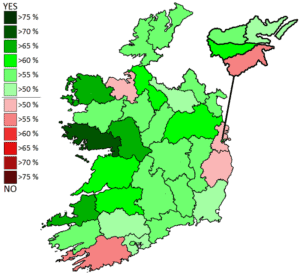
Results of the Draft Constitution by Dáil Constituency - The new constitution was drafted by the government of de Valera, and it was adopted by a majority of Irish Free State voters through a nationwide referendum on 1 July 1937.
- Following the victory of De Valera and Fianna Fáil in the general election, the 1922 Irish Free State constitution was repealed and revised through a series of legislative reforms and then replaced by a new constitution.
- The new Constitution of Ireland took effect on 29 December 1937 and replaced the 1922 Constitution.
- The position of Governor-General was abolished, and the President of Ireland was created, while the position of Prime Minister, now known as the Taoiseach, was elevated in status. De Valera assumed the position of Taoiseach.
- The Irish Free State was renamed Éire, and symbolic ties to British control were severed through negotiations. However, the country did not legally become a republic until 18 April 1949, when the current Republic of Ireland was created.
- The Republic of Ireland Act essentially terminated Ireland’s position as a British dominion, removing the King’s remaining duties with respect to Ireland and Ireland’s membership of the British Commonwealth.
Image Sources
- https://www.sinton-family-trees.com/maps2/post-1922.php
- https://en.wikipedia.org/wiki/Easter_Rising
- https://www.bbc.co.uk/newsround/46480953
- https://ichef.bbci.co.uk/news/800/cpsprodpb/18657/production/_104772999_gettyimages-463965023.jpg
- https://www.irishcentral.com/roots/history/irish-flag
- https://en.wikipedia.org/wiki/Adoption_of_the_Constitution_of_Ireland#Plebiscite

